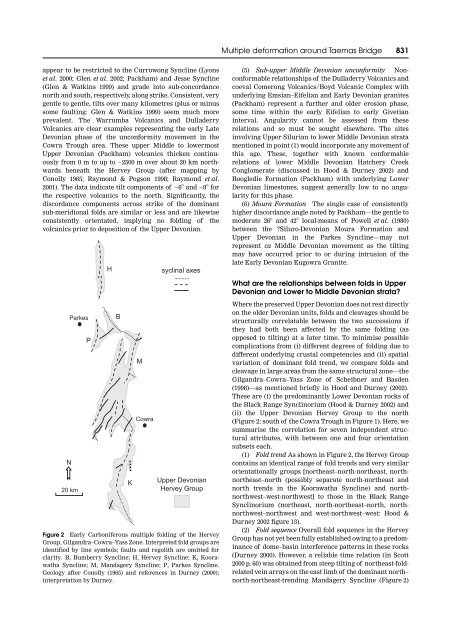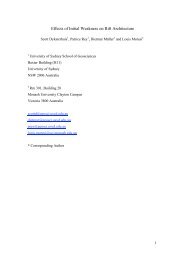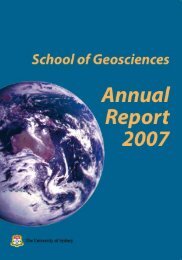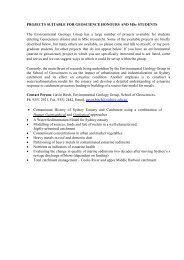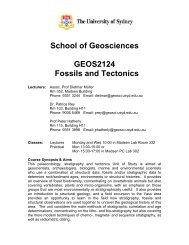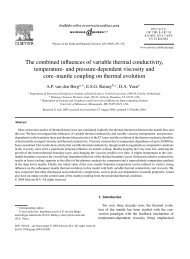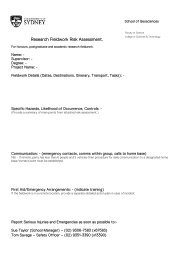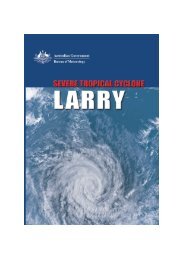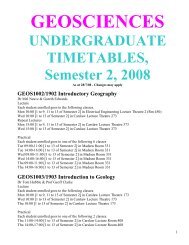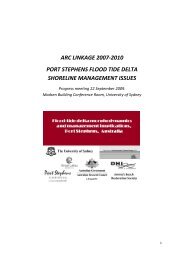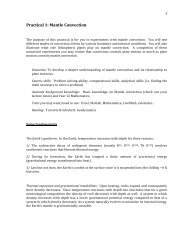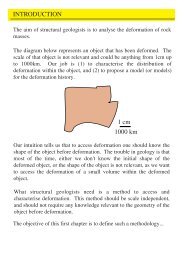View - School of Geosciences
View - School of Geosciences
View - School of Geosciences
Create successful ePaper yourself
Turn your PDF publications into a flip-book with our unique Google optimized e-Paper software.
Multiple deformation around Taemas Bridge 831<br />
appear to be restricted to the Currowong Syncline (Lyons<br />
et al. 2000; Glen et al. 2002; Packham) and Jesse Syncline<br />
(Glen & Watkins 1999) and grade into sub-concordance<br />
north and south, respectively, along strike. Consistent, very<br />
gentle to gentle, tilts over many kilometres (plus or minus<br />
some faulting: Glen & Watkins 1999) seem much more<br />
prevalent. The Warrumba Volcanics and Dulladerry<br />
Volcanics are clear examples representing the early Late<br />
Devonian phase <strong>of</strong> the unconformity movement in the<br />
Cowra Trough area. These upper Middle to lowermost<br />
Upper Devonian (Packham) volcanics thicken continuously<br />
from 0 m to up to ~2500 m over about 20 km northwards<br />
beneath the Hervey Group (after mapping by<br />
Conolly 1965; Raymond & Pogson 1998; Raymond et al.<br />
2001). The data indicate tilt components <strong>of</strong> ~6 and ~8 for<br />
the respective volcanics to the north. Significantly, the<br />
discordance components across strike <strong>of</strong> the dominant<br />
sub-meridional folds are similar or less and are likewise<br />
consistently orientated, implying no folding <strong>of</strong> the<br />
volcanics prior to deposition <strong>of</strong> the Upper Devonian.<br />
(5) Sub-upper Middle Devonian unconformity Nonconformable<br />
relationships <strong>of</strong> the Dulladerry Volcanics and<br />
coeval Comerong Volcanics/Boyd Volcanic Complex with<br />
underlying Emsian–Eifelian and Early Devonian granites<br />
(Packham) represent a further and older erosion phase,<br />
some time within the early Eifelian to early Givetian<br />
interval. Angularity cannot be assessed from these<br />
relations and so must be sought elsewhere. The sites<br />
involving Upper Silurian to lower Middle Devonian strata<br />
mentioned in point (1) would incorporate any movement <strong>of</strong><br />
this age. These, together with known conformable<br />
relations <strong>of</strong> lower Middle Devonian Hatchery Creek<br />
Conglomerate (discussed in Hood & Durney 2002) and<br />
Boogledie Formation (Packham) with underlying Lower<br />
Devonian limestones, suggest generally low to no angularity<br />
for this phase.<br />
(6) Moura Formation The single case <strong>of</strong> consistently<br />
higher discordance angle noted by Packham—the gentle to<br />
moderate 26 and 42 local-means <strong>of</strong> Powell et al. (1980)<br />
between the ?Siluro-Devonian Moura Formation and<br />
Upper Devonian in the Parkes Syncline—may not<br />
represent ca Middle Devonian movement as the tilting<br />
may have occurred prior to or during intrusion <strong>of</strong> the<br />
late Early Devonian Eugowra Granite.<br />
What are the relationships between folds in Upper<br />
Devonian and Lower to Middle Devonian strata?<br />
Figure 2 Early Carboniferous multiple folding <strong>of</strong> the Hervey<br />
Group, Gilgandra–Cowra–Yass Zone. Interpreted fold groups are<br />
identified by line symbols; faults and regolith are omitted for<br />
clarity. B, Bumberry Syncline; H, Hervey Syncline; K, Koorawatha<br />
Syncline; M, Mandagery Syncline; P, Parkes Syncline.<br />
Geology after Conolly (1965) and references in Durney (2000);<br />
interpretation by Durney.<br />
Where the preserved Upper Devonian does not rest directly<br />
on the older Devonian units, folds and cleavages should be<br />
structurally correlatable between the two successions if<br />
they had both been affected by the same folding (as<br />
opposed to tilting) at a later time. To minimise possible<br />
complications from (i) different degrees <strong>of</strong> folding due to<br />
different underlying crustal competencies and (ii) spatial<br />
variation <strong>of</strong> dominant fold trend, we compare folds and<br />
cleavage in large areas from the same structural zone—the<br />
Gilgandra–Cowra–Yass Zone <strong>of</strong> Scheibner and Basden<br />
(1998)—as mentioned briefly in Hood and Durney (2002).<br />
These are (i) the predominantly Lower Devonian rocks <strong>of</strong><br />
the Black Range Synclinorium (Hood & Durney 2002) and<br />
(ii) the Upper Devonian Hervey Group to the north<br />
(Figure 2: south <strong>of</strong> the Cowra Trough in Figure 1). Here, we<br />
summarise the correlation for seven independent structural<br />
attributes, with between one and four orientation<br />
subsets each.<br />
(1) Fold trend As shown in Figure 2, the Hervey Group<br />
contains an identical range <strong>of</strong> fold trends and very similar<br />
orientationally groups [northeast–north-northeast, northnortheast–north<br />
(possibly separate north-northeast and<br />
north trends in the Koorawatha Syncline) and northnorthwest–west-northwest]<br />
to those in the Black Range<br />
Synclinorium (northeast, north-northeast–north, northnorthwest–northwest<br />
and west-northwest–west: Hood &<br />
Durney 2002 figure 13).<br />
(2) Fold sequence Overall fold sequence in the Hervey<br />
Group has not yet been fully established owing to a predominance<br />
<strong>of</strong> dome–basin interference patterns in these rocks<br />
(Durney 2000). However, a reliable time relation (in Scott<br />
2000 p. 60) was obtained from steep tilting <strong>of</strong> northeast-foldrelated<br />
vein arrays on the east limb <strong>of</strong> the dominant north–<br />
north-northeast-trending Mandagery Syncline (Figure 2)


